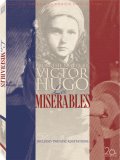Synopsis
After serving ten years as a galley slave for having stolen a loaf of bread, Jean Valjean returns to the outside world a bitter man. He is transformed by the saintliness of a bishop who gives him shelter and the gift of the very items he was trying to steal. Starting his life over again, he becomes Mr. Madeleine, highly respected pottery plant owner and eventually mayor. He even adopts young Cosette, whose mother is dying. But the relentless Inspector Javert feels he recognizes Madeleine as …he parole-evading Valjean, and so begins a pursuit that will take all three characters to a Paris about to erupt in an uprising.
The two film versions here are from 1935 (with Frederic March as Valjean and Charles Laughton as Javert) and 1952 (Michael Rennie as Valjean, Robert Newton as Javert). The prize definitely goes to the first. Rennie is fine, but his intensity lacks the depth of March’s, nor does he transform utterly as March does, depending on the phase of Valjean’s life. Similarly, Newton is full of twitches and malice as Javert, but Laughton makes us genuinely feel the torment that drives the man, and makes us feel real sympathy for the devil. Compare the final sequence of both films. The emotional journey completed by Javert feels forced in the 1952 version, but is deeply moving in the earlier film. As well, the sets in the original are rather more convincing. The later version does, though provide some joy for fans of odd casting: Cosette’s love interest Marius is played by a young Cameron Mitchell, who clearly doesn’t know that Blood and Black Lace and The Toolbox Murders lie in his future.
Audio
Oddly, the audio for the 1935 film is the better of the two. The sound is warm, and though there is some background hiss, it is minor. The stereo remix works quite well. Though the volume level of the rear speakers is minimal, this is to the good, as the surround is indiscriminate. The 1952 film sounds much the same, but is a bit thin, and the volume level is very low.
Video
Both films have good, but not perfect prints. Now and then, there is a shot or two whose grain is much more noticeable, and where the otherwise very fine black-and-white tones become harsh. The earlier film also has some minor flicker going on. Still, these are all minor issues, and the images of both prints are very sharp.
Special Features
The disc gives us two movies in lieu of more developed features. Restoration comparisons and still galleries are on hand for both films. The 1952 version also has its theatrical trailer and an interesting featurette. “The Fugitive and the Pursuer: Vidocq” is a biography of the criminal-turned-detective who helped inspire the figures of Jean Valjean and Javert. Finally, there are some helpful liner notes and collection of lobby cards.
Closing Thoughts
Two films well worth watching, though only one has a real shot at being called a “classic.”
Special Features List
- Vidocq Featurette
- Restoration Comaprisons
- Still Galleries
- Theatrical Trailer
- Liner Notes
- Lobby Cards






